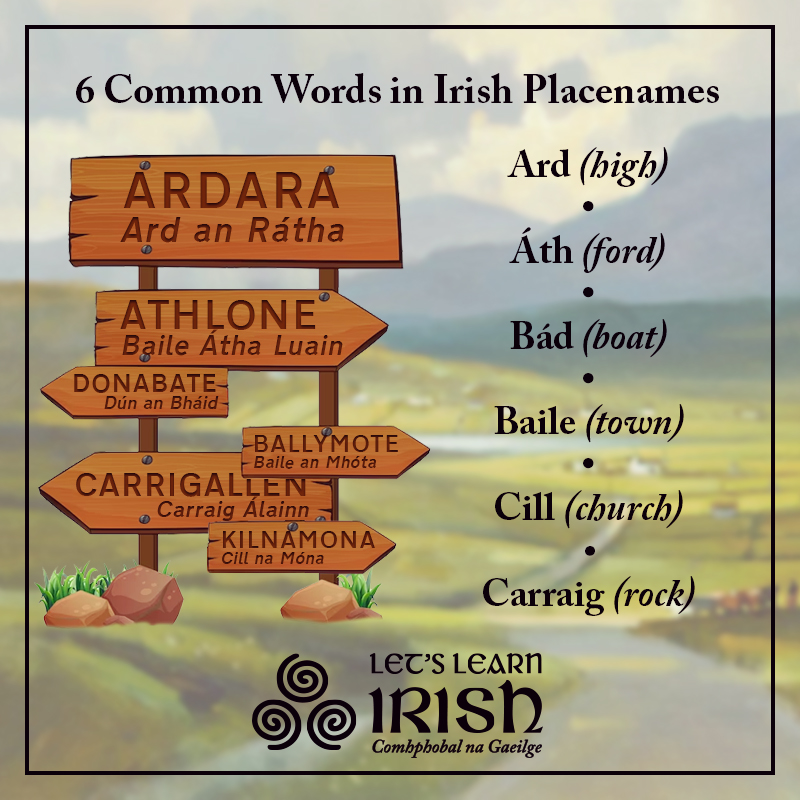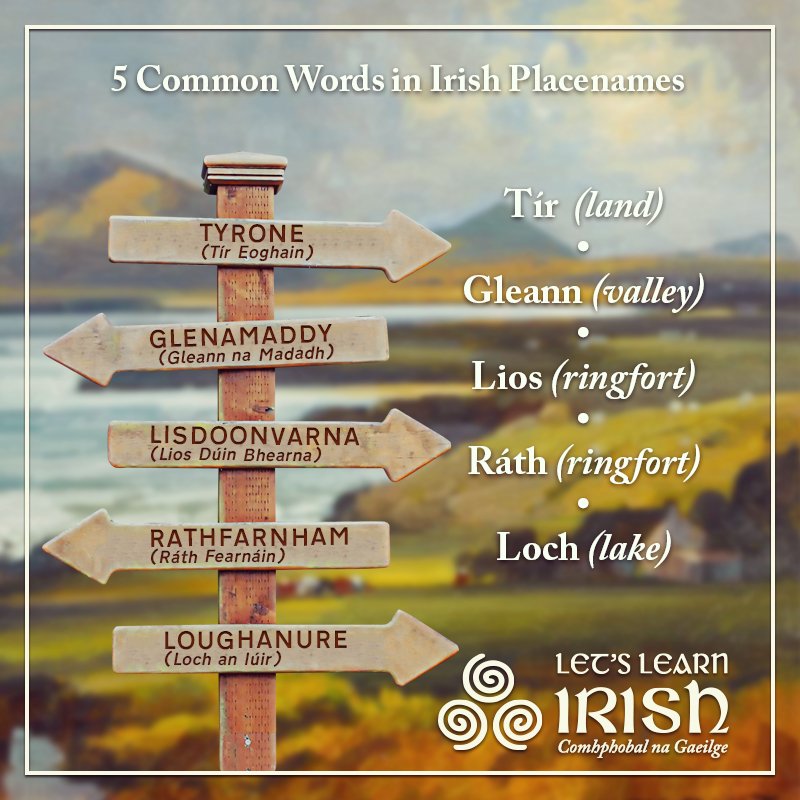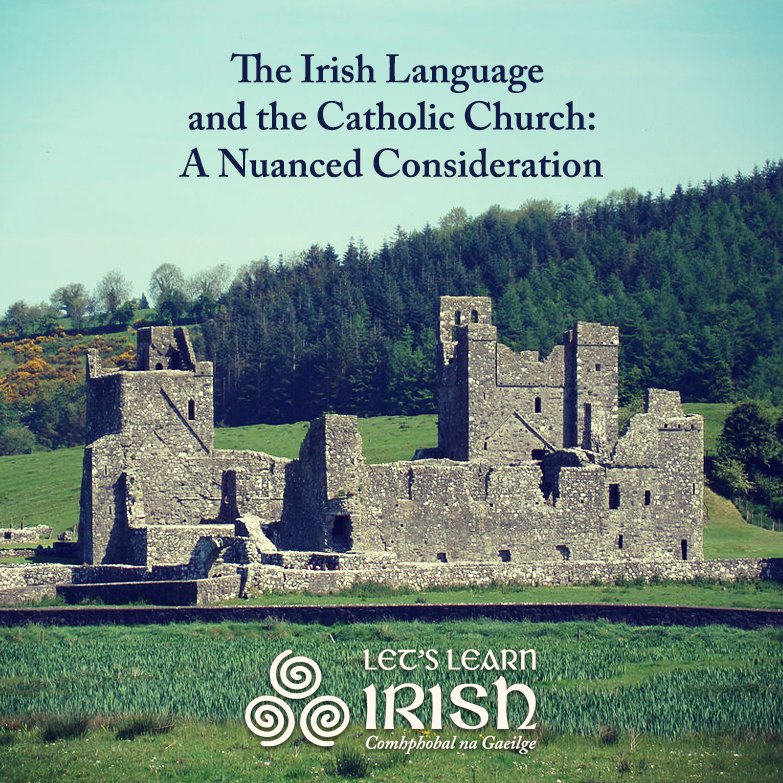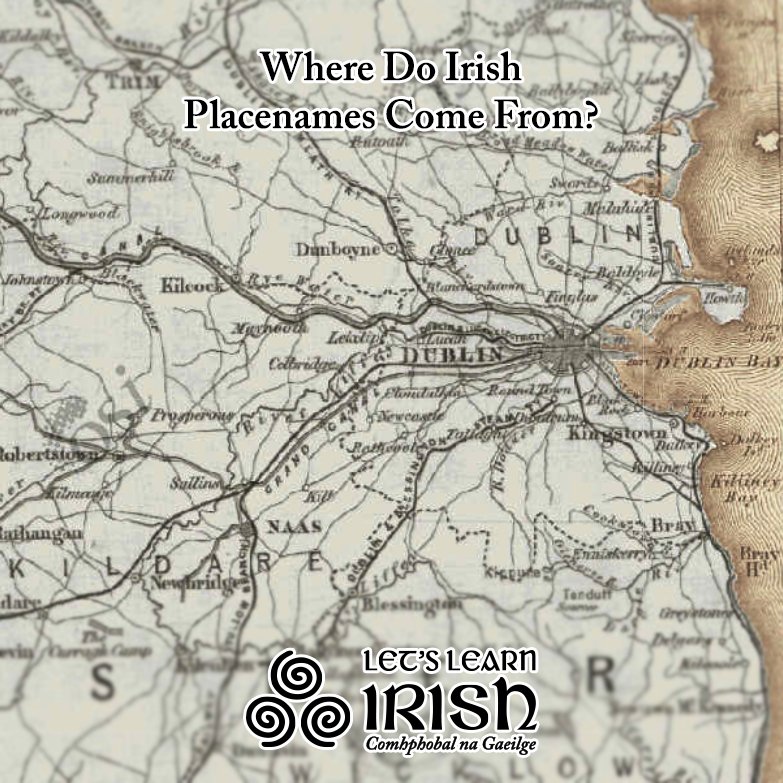Irish Placenames: Cluain, Cnoc, Coill, Droim, Dún
Logainmneacha / Placenames
Irish placenames contain rich information not only about the physical features of our localities, but oftentimes, they tell us about the inhabitants who lived there too! Placenames act as an important local history research for historians, teachers, students and genealogists, but also for the Irish diaspora spread around the globe.
In our previous article on ‘logainmneacha’, we profiled placenames featuring the words Ard (high), Áth (ford), Bád (boat), Baile (town), Cill (church) and Carraig (rock). These names reveal doorways into our past – the stories, secrets, and ‘seanchas’ (folklore) of our surroundings. Using the original titles, and understanding their origins, provides us with a way to connect with our past and embrace the beauty of the Irish language.
In this instalment, we will look at five more examples of logainmneacha found throughout Ireland: Cluain (meadow), Cnoc (hill), Coill (wood), Droim (ridge) and Dún (fort). Explore the examples listed, and feel free to add your own in the Comments below!
Cluain
Here are examples of places with the word ‘cluain’, meaning ‘meadow’.
Cluain Eois (Clones), ‘meadow of Eoin’, is located in west Co. Monaghan.
The village of Cluain Fada (Cloonfad), meaning ‘long meadow’, can be found in Co. Roscommon.
An Chluain (Cloone), is a village in Co. Leitrim, close to the town of Mohill.
Cluain Tarbh (Clontarf), meaning ‘meadow of the bull’, is a coastal suburb in north Dublin. This area is famous for the Battle of Clontarf, which took place in April 1014. Here, Brian Boru, High King of Ireland, fought and defeated an advancing alliance of Viking, Leinster and Dublin armies.
Cluain Dolcáin (Clondalkin), Dublin, translates as ‘pasture of Dolcán’. This historical village was founded by Saint Chrónán as a monastical site sometime around 600 CE, A.D. Some have also speculated that the name may also derive from the Danish word for ‘thorn’, thus translating as ‘meadow of thorns’.
Perhaps the most historical example of this placename is Cluain Mhic Nóis (Clonmacnoise), meaning “meadow of the sons of nós”, in Co. Offaly. Here lies one of Ireland’s most iconic monastic sites. The site consists of one cathedral, seven churches, three high crosses and two round towers, and was once a thriving home for nearly 2,000 people during the 11th century. In this early medieval period, Cluain Mhic Nóis lay at the intersection of two major travel pathways in Ireland – the River Shannon and the Slí Mór (‘The Great Way’), a roadway that extended across Ireland, from east to west, providing passage over the wet terrain of the midlands. Cluain Mhic Nóis was also situated at the border of two of the great kingdoms of early, medieval Ireland – Connacht to the west, and Mide (Meath) to the east – and the area benefitted from its proximity to both ruling dynasties, prospering until the end of the 13th century.
Cnoc
The Irish word for a hill is ‘cnoc’. Multiple examples of this placename abound…
Mainistir Chnoc Muaidhe (Abbeyknockmoy), meaning ‘abbey of Muaidh’s hill’, is a village in Co. Galway, and home to the ruins of the 12th century Cistercian abbey.
Buaile an Chnocáin (Ballyknockan) is a village in Co. Wicklow. The name most likely means ‘town of the hillock’, meaning a small hill or mound.
An Cnoc (Knock) in Co. Mayo is also known as Cnoc Mhuire, meaning “Hill of Mary”.
Cnoc an tSalainn (Knockatallon), meaning ‘hill of salt’, is a townland in north Co. Monaghan.
Cnoc na Graí (Knocknagree), a village in north-west Co. Cork, translates as ‘hill of the horse stud’.
Cnoc an Doire (Knockaderry) is a village in Co. Limerick, and means ‘hill of the oak-wood’.
Cnoc an Eanaigh (Knockananna) is a village in Co. Wicklow, and refers to the ‘hill of the marsh’.
Coill
‘Coill’ is the Irish word for wood or forest (and not to be confused with the word ‘cill‘). Here are some examples…
The small village of Baile na Coille (Ballinakill) in Co. Laois refers to ‘the town of the woods’.
The village of Coill an Easpaig (Killinaspick), in Co. Kilkenny, translates as ‘bishop’s wood’.
Coill Chluana (Kilcloon), a parish in the south-east of County Meath, refers to ‘woodland of the meadow’.
The town of Coill Dubh in Co. Kildare, established in 1952 in Co. Kildare, translates as ‘black wood’.
Bailieborough in Co. Cavan derives its English name from from William Bailie, a Scot who was granted lands in this area in 1610. However the original Irish name is somewhat more interesting: Coill an Chollaigh, meaning ‘wood of the boar’.
Droim
Whenever you come across the word ‘droim’ in Irish, you can be sure it’s referring to a ridge or drumlin of some sort!
An Droim (Drum) in west Co. Monaghan, simply means ‘the ridge’. The village is notable for being one of the only Protestant-majority settlements in the Republic of Ireland, and indeed, it has no Catholic church!
The village of Dhá Dhrom (Ardgroom) translates as ‘two drumlins’ or ‘ridges’, and is situated on the Beara peninsula in Co. Cork.
The intriguingly titled Droim Dhá Thiar (Dromahair) means ‘ridge of (the) two demons’. You will find this village in Co. Leitrim.
The village of Droim Lis (Drumlish), in Co. Longford, translates as ‘fort of the ridge’.
The well-known residential area and inner suburb on the Northside of Dublin, Droim Conrach (Drumcondra), means ‘Conra’s ridge’.
Droim Mór (Dromore), meaning ‘large ridge’, is a small market town and civil parish in Co. Down.
Examples of places called Glas dromainn (Glasdrumman) appear in Armagh, Leitrim, Fermanagh, Cavan, Down, and translates as ‘the green back, ridge or hill’.
Droim Seanbhó (Drumshanbo) refers to the ‘ridge of the old huts’. This scenic town in Co. Leitrim is located among soft rolling hills, woodlands, lakes and the Sliabh an Iarainn and Arigna mountains.
A village in Co. Leitrim, Droim ar Snámh (Drumsna), translates as ‘ridge of the swimming place’, and is a popular location for anglers seeking a large selection of wild fish.
Dún
Dún means ‘fort’ in Irish, and we can find many examples of this word in placenames across the country…
The most obvious example of this placename is Dún na nGall (Donegal), situated in the north west of Ireland. ‘Dún na nGall’, or ‘Contae Dhún na nGall’ when referring to the county, translates as ‘fort of the foreigners’. ‘Gall’ comes from Middle Irish, and means ‘foreigner’, from the Latin word Gallus (‘a Gaul’). The Scottish Gaelic word ‘gall’ and Manx ‘goal’ have the same origins.
The Dublin suburb of Dún Droma (Dundrum) refers to the ‘ridge fort’.
The small, former fishing port of Dún Fionnachaidh (Dunfanaghy) in north Co. Donegal, means ‘fort of the fair field’).
The coastal town of Dún an Bháid (Donabate) in Co. Dublin, refers to the ‘fort of the boat’.
Dún Garbhán (Dungarvan), in Co. Waterford, translates as ‘Garbhann’s Fort’.
Join the online Irish community for cúrsaí, comhrá & ceardlanna, and follow along on social media @LetsLearnIrish – beidh fáilte romhat!






